| |
Orientation :: Software Tools
Orientation
"It's at first difficult to see what technological paradigm follows from the community rather than delivery view of education. As each community has its own specific interests, its own ways of knowing, its own central endeavors, generalizing seems out of place. But communities are made up of people, and at the heart of all social relations and practice lies human communication of one form or another. On the basis of this assumption, we suggest that learning technology should be build around a conversational paradigm."
(John Seely Brown & Paul Duguid, Universities in the Digital Age, 1995, §9).
Sensemaking is about such things as placement of items into frameworks, comprehending, redressing surprise, constructing meaning, interacting in pursuit of mutual understanding, and patterning.
(Karl Weick, Sensemaking in Organizations, 1995, p.6)
Open Sensemaking Communities (OSC) is a concept we are using to investigate the next step after publishing Open Educational Resources, namely, designing for sensemaking: embedding OERs in an environment that supports end-users (both students and educators) in connecting, engaging more deeply, with the material and with each other in self-organising communities of interest.
The focus on [sense][making] reflects our perspective on giving shape and form to interpretations, and the individuals/communities articulating them. We propose that a primary challenge is to assist self-organising learners and educators in assessing, extending and contesting OERs. This requires access not only to the text, but to the context (e.g. annotations, argumentation, and the people behind them). This is resonant with constructivist approaches to the negotiation of meaning in authentic learning communities. The emphasis on social software reflects our interest in how open sensemaking communities may become the vehicles for building shared practices through discourse, which then enables meaningful learning.
This rationale shapes the selection of the software tools that we are evolving, which are designed to make visible and manipulable the connections between ideas, and between the people behind them...
We propose that a key weakness is current OER environments is the absence of an effective open sensemaking layer that more actively integrates peer-to-peer interaction with interpretation and argumentation than is currently supported by freeform web forums, annotations or blogs. This layer can be conceived as follows:
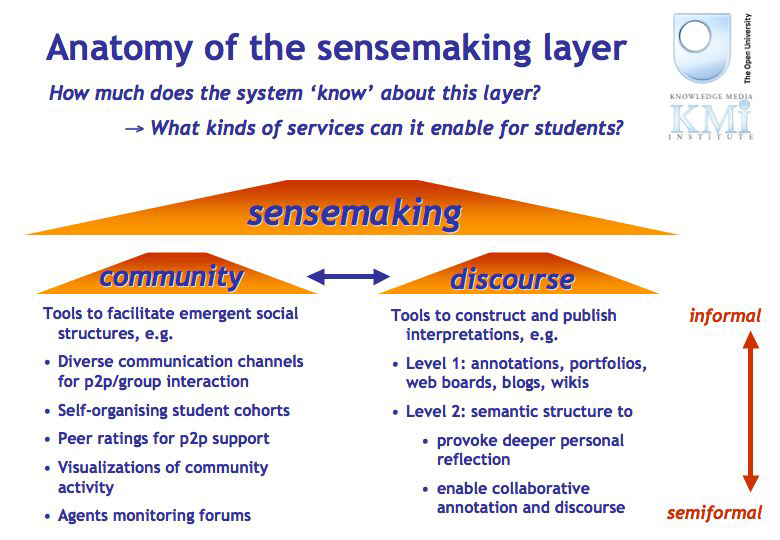
The objective is to orchestrate social software tools for community building with discourse software tools supporting semantic annotation and argumentation, tightly integrated with learning resources. This approach builds on our previous work on digital document-centred discourse which started in the mid-1990s, inspired by Brown & Duguid's work on the social life of documents.
Since those early days of the Web, we now generalise "document" to mean any multimedia Web resource (OERs being of specific interest in this context), and "discourse" goes beyond threaded Web/email discussion, to ubiquitously available, recordable, synchronous and asynchronous peer-to-peer collaboration tools, with annotation and discourse contributions combining freeform text grounded in the semantics of a discourse ontology, an approach that we think of as Hypermedia Discourse.
Software Tools
We have developed a suite of tools that already support hundreds of users every day in performing three distinct sensemaking activities implicated in a focus on discourse and community:
Knowledge Mapping :: Social Presence & Identity :: Peer-to-Peer Collaboration
These are integrated into the open source Moodle virtual learning environment (VLE) that forms the core learning platform at the OU:
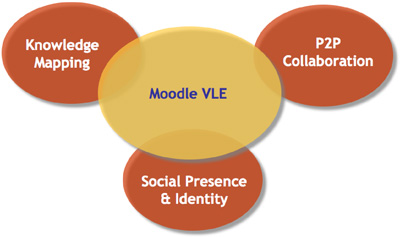
There are QuickStart Guides for Knowledge Mapping, MSG and FlashMeeting that contextualise these tools to OpenLearn.
-
Knowledge Mapping. Learning to think critically, argue in a scholarly manner, and collaborate to make sense of problems, are amongst the highest order skills that we seek to instil in learners. Empirical evidence shows that when used appropriately, argument and dialogue mapping can foster these skills and support these tasks. Argumentation for learning is now an extremely active field. In addition, users need good personal information management tools: intuitive, powerful tools to manage, share, analyse and track information, ideas and the connections between them. Knowledge Mapping refers to the connections between ideas and the ability to view, share and critically analyse those connections. Consequently, it covers tools for annotation, linking and visualization, but with a specific orientation towards representations which focus on dialogue and argumentation to support critical reflection (with oneself and others). KMI's Compendium tool is the hypermedia knowledge mapping software that forms the platform for this strand.
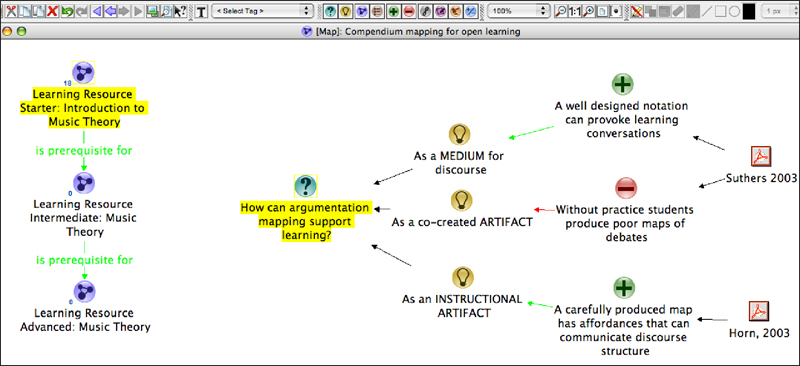
On the left, a simple learning pathway map created by sequencing a set of maps, each of which is populated with structured resources (imported from the Repository/Depository, or in this case, Connexions objects). On the right, an example student Dialogue Map, used to articulate a research question, to which the student can link possible answers, arguments, and literature. These can be exported as interactive Web maps, or shared with other users who can build on them.
It is anticipated that Knowledge Maps could be used to support many activities: to manage personal or group information by dragging and dropping in any document or website (a form of 'visual e-portfolio'); to manage knowledge and learning by charting questions, ideas, and arguments as they arise; to share learning pathway maps over resources; to work through revision question templates; to browse or construct argumentation maps associated with learning resources and literatures, or dialogue maps which add value to online meetings.
- Students and educators can now publish, download and edit Compendium maps via OpenLearn (using a custom Moodle block to handle the files). The most recent development is the Cohere web tool for knowledge mapping, which moves the learner/analyst from merely tagging websites, to weaving meaningful connections between those tags.
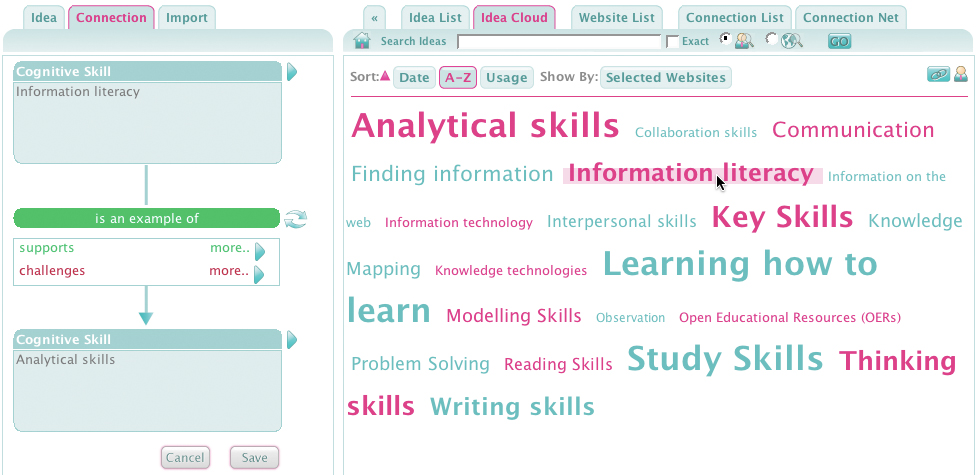
From tag clouds to Idea webs: linking notes/ideas with meaningful connections in Cohere

Visualizing the emerging network of ideas in Cohere
- Social Presence and Identity. We see 'Social Presence' as an extension of information about a user's current availability, as seen in today's Instant Messaging environments, augmented (subject to the user's own preference and privacy constraints) to include other useful attributes such as attention, mood, location, device accessibility (e.g. 'cell phone only') and overall context (e.g. 'studying material X'). 'Social Identity' is an extension of a user's personal information, as seen in today's VLE and forum 'profiles', augmented (again subject to the user's own preference and privacy constraints) to include other useful attributes such as reputation, status, interests, friendship networks, browsing history, publishing history, tag-clouds, music playlists, annotated photo libraries, and so on. MSG and BuddyFinder provide a strong start for this and can both be augmented in the right ways so as to be (a) web-centric and significantly easier for the vast majority of users; and (b) enhanced to include the extra functionality beneficial to learners.
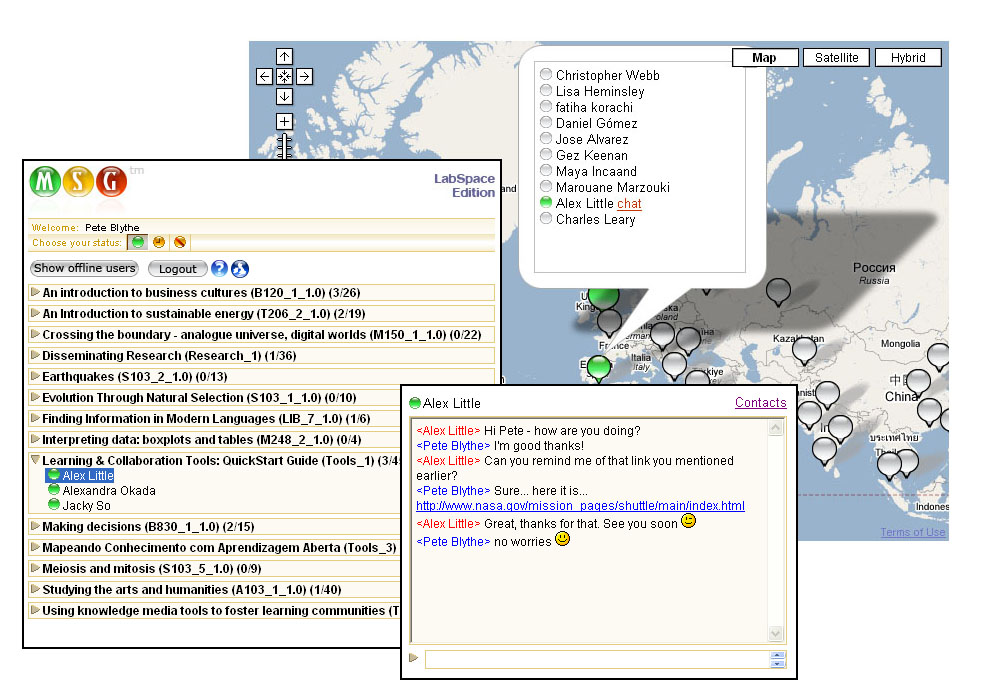
Screenshots from MSG: on the left the users contacts and groups, in the foreground a chat conversation in progress and in the background the MSG Presence Map.
KMi has developed a pair of open source tools, MSG and BuddyFinder, that provide a combination of instant messaging, geolocation support ('who is online, and where ?'), and friend-finding via semantic matchmaking ('who can help me solve a specific problem right now ?').
Peer-to-Peer Collaboration. The key to the success of The Open University experience is that our students do not sit alone, surrounded by learning objects. Whilst quality content will attract users, our extensive experience shows that it is the interactions which students have with our systems and with one other that aids their learning, brings them back, and develops a community. Our VLE concept already contains a number of important collaborative systems. The P2P Collaboration strand will connect a powerful range of existing and deployed KMi technologies into a unifying architecture to help users to collaborate with peers, and to annotate and syndicate media and their work with it.

The FlashMeeting Memo applet which provides interactive timelines showing who spoke when during a FlashMeeting Live session. This example is from a self-organised group of animation students across the US, who meet every month to critique each others' work.
The FlashMeeting Live application is a simple browser-based applet that allows half-duplex, large-scale meetings, with text chat, voting, and URL sharing.
The FlashMeeting Memo application is a browser-based applet that allows users to re-use the products of live meetings by editing and annotating them for the open content community. The FlashVlogging system allows users to rapidly publish instant video segments into video blogs (or vlogs), RSS feeds or direct into arbitrary web pages. The Rostra system is an RSS feed management system that helps users to manage, integrate and publish simple syndication services such as news, blogs, podcasts and vlogs, all from management web-forms.
The core KMi technologies which lie behind these functions have been in daily use for several years now, providing good grounds for confidence in their technical robustness, usability and value. The vision of building Open Sensemaking Communities is to deliver a seamless user experience by integrating all tools with each other and into the underlying Moodle VLE, for instance, thus making it easy to annotate and map learning content, launch discussions in different collaboration media, or see who in the community might have relevant expertise. |
|








